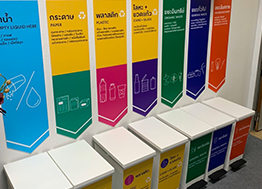Waste Management
Sustainability

Central Pattana has devised a more serious and more concrete plan on garbage and waste management to minimize impacts on the environment according to the ISO 14001 standards and the Company’s policies on the society, communities, and the environment. The plan involves processes and methods on waste separation and disposal.
Target
• Reduce landfill waste by increasing Waste Diversion by 75% by 2030.
• Waste Diversion 100% by 2050
• Shopping Center Operational Practices.
• Reduction of waste to landfill by at least 50% by 2025
Management Approach
- Adhering to ISO 14001 Environmental Management System Standards
- Participating in the Low Emission Support Scheme (LESS) by the Private Organization for Greenhouse Gas Management
- Promoting and preparing separate waste bins for different types of waste, placing them within the shopping center and office buildings to encourage customers and shops to segregate waste before disposal. Also, setting up a platform to record waste weights for businesses to track waste volumes and raise awareness about reducing landfill waste.
- Establishing partnerships to reduce landfill waste, such as collaborating with the Bangkok Metropolitan Administration on the "Non-Inclusive Project" to feed food waste to animals or teaming up with recycling centers for material recycling.
- Installing Recycle Stations with drive-through waste separation points at the shopping center to facilitate convenient waste segregation and support the public in waste sorting.
- Implementing the "Journey to Zero - Shop Well, Dispose Well" project to inspire and engage customers.
- Transitioning to Dyson Airblade hand dryers with Hepa filter innovations for hygiene, rapid drying, energy efficiency to reduce paper towel use, and minimize waste generation in the shopping center.
- Including waste segregation training as a core value in the organization's curriculum, such as the 'CPN-Belief in Story: Journey to Zero,' emphasizing the importance of waste segregation and encouraging collaborative efforts among employees. * Project Development Practices.
- Use building Information Modeling (BIM) to create 3D virtual models of underground structures, facility management and retail stores. In addition, Use the Construction Online program for managing on-site changes and alterations, leading to a lot of reduction in paper usage.
- Use Recycled Concrete Aggregates (RCA), sourced from concrete debris produced during pile cutting, as an alternative to natural crushed stone aggregates in road base construction.
- Sort and process waste generated at construction sites. Examples include: 1) production of effective microorganisms for use in the project sites as well distributed to community members; 2) feeding food scraps to worms; and 3) production of organic compost for use in the project sites; any surplus is sold, with the proceeds earned used to purchase food and stationery for students in nearby communities and workers at the project sites. 12 Reuse materials such as: 1) metal sheets; 2) excavated soils transported from project to project; and 3) shipping containers, which are used as temporary offices and living quarters for workers.

Performance Environmental Resource Management

Solid Waste Segregation Policy

